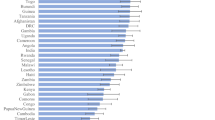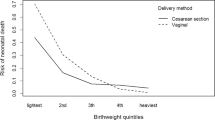Abstract
Objective:
This study was designed to analyze the trends and differences in perinatal and neonatal mortality rates in the State of Qatar over a period of 30 years (1977 to 2007), to examine the causes of neonatal deaths and compare them with some regional Gulf states and developed world countries.
Study Design:
This is a retrospective study conducted in the Women's Hospital, Hamad Medical Corporation, State of Qatar from 1977 to 2007.
Method:
The study included all perinatal and neonatal deaths for the period 1977 to 2007, which were monitored through registers of the Neonatal Intensive Care Unit (NICU), Women's hospital. Cause of death was determined using information from hospital records, including discharge certificates. There is a national database in the Department of Preventive Medicine that records all deaths through death certificates. The missing information for the early years was collected from this database. All causes of deaths were classified in accordance with criteria based on the International Classification of Disease tenth revision (ICD-10).
Result:
There was a notable peak in neonatal (14.1), early neonatal (12.5) and perinatal (24.7) mortality rates in 1977. There was a second peak in neonatal (12.1) and late neonatal (7.5) mortality rates in 2000. Over a period of three decades (1977 to 2007), there was a significant decline in mortality rates (P<0.0001). By 2007, the neonatal mortality rate had decreased from 14.1 to 5.1; the early neonatal mortality rate had a dramatic fall from 12.5 to 2.3; and perinatal mortality came down from 24.7 to 10.3. There was no notable reduction in the late neonatal mortality rate in 2007 (2.8) compared with that in 1980 (3.0). The still-birth (8), neonatal (5), early neonatal (2.3) and perinatal (10.3) mortality rates in Qatar were very close to the rates found in developed countries, but lower than the rates in Bahrain and Saudi Arabia. Similar to developed countries, prematurity was the leading cause of neonatal death in Qatar (42.6%), followed by congenital anomalies (28%).
Conclusion:
This study revealed that there was a sharp significant decline in neonatal and perinatal mortality rates during the study period in Qatar. The stillbirth, neonatal and perinatal mortality rates in Qatar are comparable with those in some of the developed countries and were lower than those in some of the Gulf countries. The proportion of underweight live births was found constant during the study period. Prematurity was the leading cause of neonatal death, followed by congenital anomalies.
This is a preview of subscription content, access via your institution
Access options
Subscribe to this journal
Receive 12 print issues and online access
$259.00 per year
only $21.58 per issue
Buy this article
- Purchase on Springer Link
- Instant access to full article PDF
Prices may be subject to local taxes which are calculated during checkout

Similar content being viewed by others
References
Qatar Earth Trends. Population, Health, and Human Well-Being— 2003; 1–6. http://earthtrends.wri.org.
Qatar Regional Health Systems Observatory. Health Systems Profile EMRO Annual Report 2003; 10–22.
Hamad Medical Corporation. Annual Health Report 2007. (Published June 2008) 21–27.
Qatar Economy. http://flagcounter/facebook/qa
NICU Women's Hospital HMC. Annual Report 2008; 1–6.
World Health Organization. The Millennium Development Goals Report 2007; 1–21.
UNICEF. State of the World's Children. 2007; 102–105.
World Health Organization. The World Health Report 2005; 1–243.
World Health Organization. Neonatal and Perinatal Mortality. Country, Regional and Global Estimates. 2006; 1–75.
Bhutta ZA . Bridging the equity gap in maternal and child health. BMJ 2005; 331: 585–586.
Boutayeb A, Serghini M . Health indicators and human development in the Arab region. Int J of Health Geographics 2006; 5: 61.
Mourshed M, Hediger V, Lambert T . Gulf Cooperation Council Health Care: Challenges and Opportunities Global Competitiveness reports. Chapter 2.1: 55–64. http://www.weforum.org/
Yu YH . Victor Global, regional and national perinatal and neonatal mortality. J Perinal Med 2003; 31: 376–379.
Van der pal-de Bruin K, graafmans W, Biermans M et al. The influence of prenatal screening and terminations of pregnancy on perinatal mortality rates. Prenat diagn 2002; 22: 966–972.
Bell R, Glinianaia SV, Rankin J, Wright C, Pearce MS, Parker L . Changing patterns of perinatal death, 1982—2000: a retrospective cohort study. Arch Dis Child Fetal Neonatal Ed 2004; 89: F531–F536.
Abdulrazzaq YMI, Bener A, Al-Ghazali LII et al. A study of possible deleterious effects of consanguinity. Clin Genet 1997; 51 (3): 167–173.
Bener AB, Hussain R . Consanguineous unions and child health in the State of Qatar. Paediatr Perinat Epidemiol 2006; 20: 372–378.
Bundey S, Alam H, Kuar A, Mir S, Lancashire R . Why do UK-born Pakistani babies have high perinatal and neonatal mortality rates? Paed Perinatal Epid 1991; 5: 101–114.
Erdem G . Perinatal Mortality in Turkey. Pediatr Perinat Epidemiol 2003; 17 (1): 17–21.
WHO. The World Health Report 1996 WHO: Geneva, 1996; 4–5.
Al-Mejhim F, Abu-Heija AT . Perintal mortality at King Fahd University Hospital, Eastern province, Saudi Arabia. Pan Arab Medical Journal 2006; 5: 24–26.
Promosonthi P, O-Prasertsawat P . Trends of perinatal deaths at Ramathibodi hospital: 1995–2005. J Med Assoc Thai 2006; 89: 158–162.
Lawn JE, Cousens S, Zupan J . for the Lancet Neonatal Survival Steering Team. Four million neonatal deaths: when? Where? Why? Lancet 2005; 365: 981–900.
Dawodu A, Bener A, Koutouby GA, Varady E, Abdulrazzaq Y . Size at birth in a rapidly developing economy: intrauterine growth pattern in UAE infants. Ann Hum Biol 2008; 35 (6): 615–623.
Millenium Development Goals report for Bulgaria 2003 (accessible at http://www.un-bg.hg).
Acknowledgements
We are thankful to Mrs Soji Samson for her assistance in preparing the paper and to Mr Mohammad Abdulaziz Farooq, Department of Epidemiology and Medical Statistics, Hamad Medical Corporation Qatar for performing statistical analysis and graphic work. All the authors have contributed toward assembling data. Dr S Rahman and Dr Bener conducted statistical analysis. All authors contributed toward writing this paper. The project was approved by the Research Committee of Hamad Medical Corporation (protcol #8202/08). Institutional support (funding) was limited to the provision of secretarial support.
Author information
Authors and Affiliations
Corresponding author
Rights and permissions
About this article
Cite this article
Salameh, K., Rahman, S., Al-Rifai, H. et al. An analytic study of the trends in perinatal and neonatal mortality rates in the State of Qatar over a 30-year period (1977 to 2007): a comparative study with regional and developed countries. J Perinatol 29, 765–770 (2009). https://doi.org/10.1038/jp.2009.89
Received:
Revised:
Accepted:
Published:
Issue Date:
DOI: https://doi.org/10.1038/jp.2009.89



